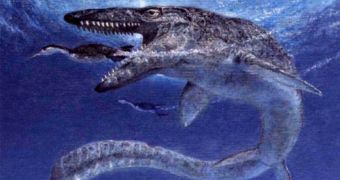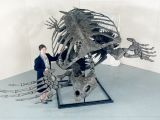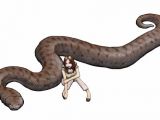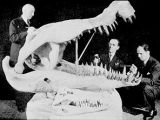Today, only five groups of reptiles still exist: chelonians (turtles and terrapins), Sphenodontia (the tuatara of New Zealand), lizards, snakes and crocodilians (crocodiles, alligators and caymans). (there is also a recently recognized group related to lizards and snakes, Amphisbaenia). They are relict groups (except lizards and snakes) compared to reptile diversity of the dinosaur era (until 65 Ma ago).
1. The largest living chelonian is the leatherback turtle (Dermochelys coriacea). The shell can even be over 3 m (10 ft) long (but rarely exceeds 2 m (6.6 ft)) and the animal can weigh from around 250 kg (600 pounds) to over 1 ton, being the largest living reptile. The span from one flipper to another is up to 9 ft (2.7 m).
The largest ever chelonian is Archelon, a relative of the leatherback turtle that inhabited the central North American Sea 70 Ma ago, at the end of the dinosaur era. The animal has a shell up to 13.5 ft (4 m) long, and a span, from flipper to flipper, of 16 ft (5.3 m), weighing over 4,500 pounds (2200 kg).
2. The largest living lizard is the Komodo dragon (Varanus komodoensis). It grows over 3 m (10 ft) in length, weighing even more than 154 pounds (70 kg). This giant monitor lizard manages to kill animals as large as water buffaloes (and in the past it may have feasted on pygmy elephants). Monitor lizards appeared during the dinosaur era, 100 million years ago. They survived the dinosaur extinction and are known to inflict infectious bites. The Komodo dragon is still a dwarf compared with its relatives that inhabited Australia during the Tertiary (after the disappearance of the dinosaurs) and were up to 8 m (27 ft) long.
Even so, the sea relatives of the monitor lizards that lived during the Cretaceous (the last dinosaur era) dwarfed all monitor lizards ever: the mosasaurs were the largest marine reptiles ever, up to 17 m (57 ft) long, as much as a humpback whale. Their limbs were transformed into flippers and clearly were the top predators of the seas during the Cretaceous. Their long, powerful jaws were endowed with conical sharp teeth and the capacity to open widely their mouth allowed them to engulf large chunks of food at a time. The body was elongated and they swam in the snake manner, using their powerful Tails also.
3. The biggest snake of our time is green anaconda (Eunectes murinus) from northern South America. The largest individuals can reach 9 m (27 feet) and 220 kg (550 pounds). Some say it could reach 11 m (33 feet), but this has not been proven yet. Anaconda is a type of huge aquatic boa snake and can swell even pigs and caymans (a type of alligators).
The tiger pythons (Python molurus) from southeastern Asia almost equals anacondas: they are confirmed to reach 8.22 m (25 feet) but are slightly "slimmer" than anacondas: 182 kg (455 pounds). The reticulated python (P reticulatus) from the same area can be even a little longer, up to 9,15 m (28 feet) but is slimmer than the tiger python, with 145 kg (363 pounds), relative to this length.
The largest snake that ever existed is Gigantophis garstini, which lived from 40 million years ago until 40,000 years ago in North Africa. This snake reached 11 m (33 feet) in length, was related to pythons and boa, and could eat animals the size of a wild boar. Its weight was estimated to 400 kg (900 pounds).
4. The largest living crocodile species is the saltwater crocodile (Crocodylus porosus), encountered from India to northern Australia and Fiji. In can reach 7 m (23 ft) in length and 1 ton in weight. At 5 m (17 ft) length, it already has 0.5 ton.
But crocodiles living with dinosaurs had in the latter much larger prey than modern mammals. No wonder they are larger. Deinosuchus (Phobosuchus), an extinct alligator from North America, which lived in the late Cretaceous (to the end of the dinosaur era) was 10-12 m (33-40 ft) long and 1.9 m (6.3 ft) wide and may have feasted on duck billed dinosaurs.
Sarcosuchus, a crocodile of the same period from Africa, was 11.2-12.2 m (37-40 ft) long and weighed up to 8 tons, but this species seems to have relied rather on fish. Purussaurus, a cayman living in South America 20 million years ago, could have measured 15 m (50 ft). Rhamphosuchus ("Beak crocodile"), an extinct gharial of the same age inhabited India. It could have been up to 18 m (60 ft) long.
5. The extinct relatives of tuatara were the same size or smaller.

 14 DAY TRIAL //
14 DAY TRIAL // 


